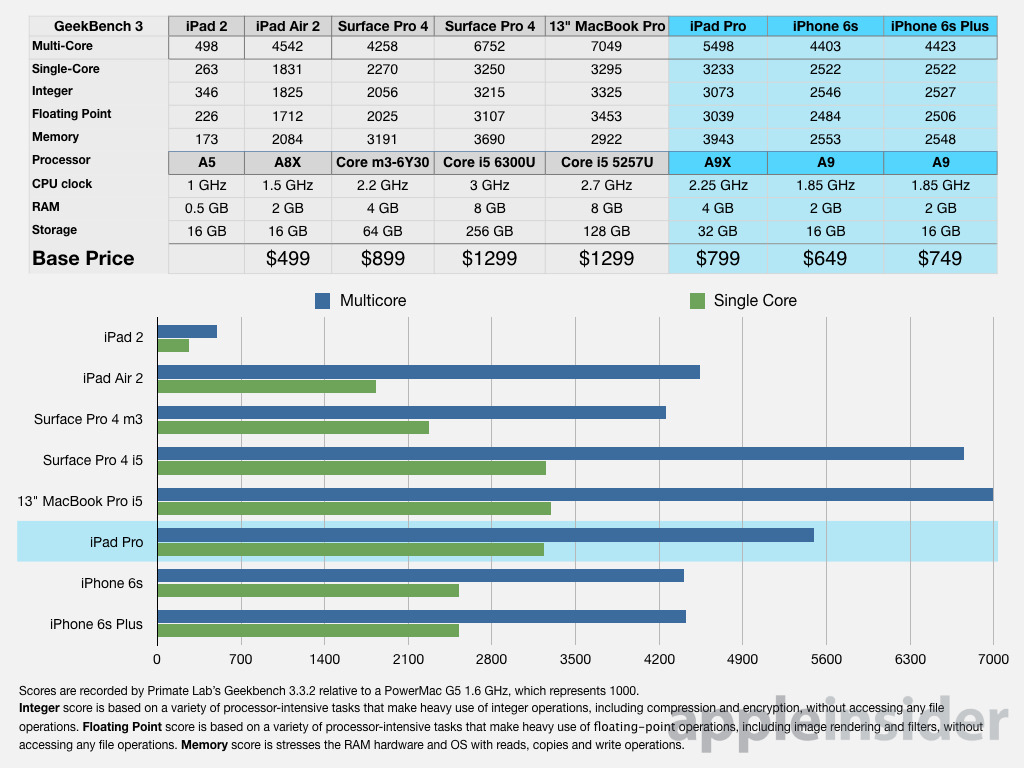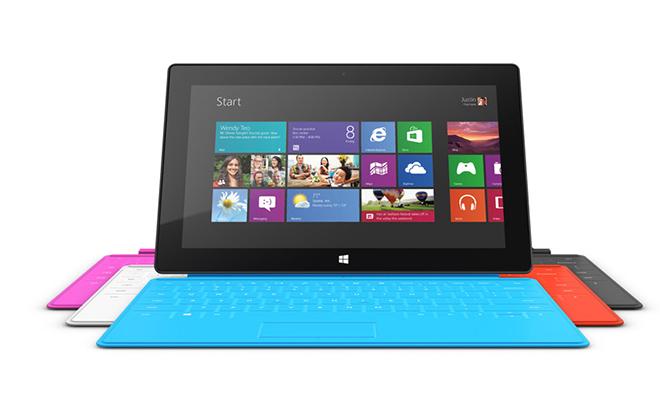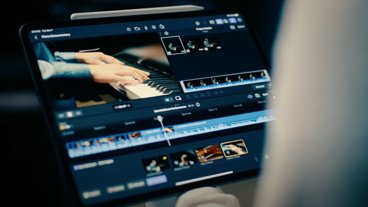When Apple first unveiled iPad Pro, it noted that its custom designed A9X chip would be faster than 80 percent of the PCs that shipped this year. Benchmarks indicate that it's not just faster than low end generic PCs, but also faster — and less expensive — than Microsoft's Surface Pro 4.
Apple sells one basic model of iPad Pro, with different storage and cellular capacities, starting at $799. Microsoft's Surface Pro is offered in three processor tiers, each with different storage options. It starts at $899.
However, the $899 model is outfitted with a low end Intel Core m3 processor, which Apple's custom A9X soundly trumps in both single core and multicore tests, despite the iPad Pro having an extra million and a half more pixels to manage on the screen.
Even Apple's $499 iPad Air 2 beats the $899 Surface Pro 4 in multicore tests, while scoring slightly lower in single core performance, and delivers that compairable performance with a price tag that's $400 lower. To get a Surface Pro 4 that has more CPU power than iPad Pro, you have to upgrade to the $1299 version, $500 more than an iPad Pro
To get a Surface Pro 4 that has more CPU power than iPad Pro, you have to upgrade to the $1299 version powered by an Intel Core i5, which costs as much as Apple's 13 inch MacBook Pro. However, the i5-powered Surface Pro 4 costs $500 more than an iPad Pro.
To cast a flattering halo of performance muscle over its Surface line, Microsoft introduced an even more expensive Surface Book laptop, which it delivered to members of the media in version packing a Core i7 that it claimed to be "twice as fast" as Apple's MacBook Pro, although that's not really true.
The Surface Book is faster than Apple's 13 inch, entry level MacBook Pro that lacks a dedicated graphics chip, but only in the area of graphics performance. But it's also more expensive. In fact, the Surface Book model Microsoft sent to reviewers costs $2700, making it $200 more expensive than even a Core i7-powered 15 inch MacBook Pro, which does have a dedicated GPU.
However, Apple's 15 inch MacBook Pro also uses a quad core i7, which makes it twice as fast as the dual core i7 Surface Book (according to real world testing performed by Fstoppers photographer Lee Morris). And it's still $200 less than Surface Book.
Why are Microsoft's PCs so slow and expensive?
Since the early 1990s, Microsoft has positioned Windows PCs as offering a cheaper alternative to Apple's Macs, often with a performance advantage to boot. However, this cost savings came with the caveat of being more arcane to use, a problem that was eventually made up for by the broader ecosystem of Windows software that Microsoft cultivated among developers.
Over the past decade, Apple has steadily won back increased Mac market share by focusing on quality; the company is now selling about 4.5 times as many Macs as it was in 2006. Over the past several years, Apple's growth in Mac sales have come even as the overall market for PCs has contracted.
Since 2011, total global PCs have fallen from 355 million units annually to just 302 million last year, a drop of 15 percent. That's erased $17 billion in annual, combined PC revenues. Over that same period, Apple's Mac revenues have increased by about $1.3 billion per year.
Apple's increase in Mac sales has come not just in unit shipments but in an expansion of control over the high end, where profits are. And Apple's profits are being reinvested into making even higher-end Macs, including the new Retina Display MacBook and 5K iMac.
Macs aren't killing PCs, iPads are
However, Apple's moderate expansion of higher end Mac sales in the face of PC market contraction doesn't explain 50 million missing computer sales. For that, you have to look at Apple's other computer product: iPad. It has been selling more than 50 million units per year, generating $20-30 billion for Apple annually.
Apple's iPad sales peaked in 2013. However, despite incredible claims by the media that "people are simply not buying new ones" (as Joanna Stern of the Wall Street Journal recently wrote), Apple has continued to sell more than 50 million units this year, despite having focused sales attention on its large iPhone 6 Plus and new Retina Display Macbook over that period, while only moderately updating its iPad mini lineup last fall.
Apple's new iPhones and MacBooks are more expensive, and therefore more profitable, than iPads. Additionally, Apple's iPad business faced zero effective competition last year, as Microsoft's Surface didn't sell well anywhere but in the minds of Windows Enthusiasts, who have taken to calling the device "popular," apparently because it sounds nice to think so.
Android tablets can be called popular, but they are not profitable for anyone who builds them. Not Google's partners, not Amazon, not Samsung. The fact that Apple sold over 50 million iPads in fiscal 2015 while so many low end Android tablets were offered at fire sale prices makes it pretty clear that Apple didn't face external competitive erosion of its iPad business; its iPad numbers were mostly eaten into by larger iPhones as well as more performant, more capable and more expensive Macs.
That's the sort of "cannibalism" that Apple's chief executive Tim Cook has told analysts that he's learned not to worry about. Apple's in business to make money, not to increment its unit shipments at a regular pace across the board (even if that's what analysts choose to fixate upon).
With iPads having already gobbled up a huge chunk of the PC market between 2010 and 2014 (and remaining on track to continue without any real competition), Apple's fiscal 2015 sales strategy targeted Samsung in the area of large phones, the sweetest low hanging fruit available. Sales of iPhone 6 and 6 Plus eviscerated Samsung fablets on the high end, effectively terminating Apple's largest competitive threat.
That's what Surface was supposed to do to the iPad, but hasn't
Apple's 2015 assault on Samsung's high end fablets worked well because Samsung's Galaxy models were priced higher than iPhones, despite having a weaker ecosystem, inferior build quality and poorer overall performance. The only advantage Samsung had prior to iPhone 6 was a wider range of screen sizes, something Apple could easily capitalize upon.
Microsoft rushed to jump on the iPad bandwagon after a year of observing iPad sales take a big chunk out of Windows PC sales. It appears Microsoft thought it could beat Apple's iPad by similarly offering a feature-competitive alternative, leveraging its Windows ecosystem and selling the result at a comparable price.
Its initial efforts to reshape the Windows PC into an iPad clone (an ARM-powered mobile tablet) completely failed with Surface RT, because nobody wanted a thick iPad running Windows, without actually being able to run real Windows apps. The company has since worked to focus on the superior performance of Surface Pro (an Intel powered laptop in the shape of its failed Surface RT form factor).
However, Surface Pro has effectively remained a big Zune: feature-comparable with Apple's highest-end offerings, at a price way too high for the Windows demographic that expects a cheap copy of Apple to actually be significantly less expensive than Apple.
That problem is only getting worse for Surface Pro, because it relies upon Intel's expensive, premium x86 chips. When Apple first shipped iPad, it introduced it alongside the new A4, the first of its own custom Application Processors. Apple's investments in rapidly iterating faster and faster generations of its A-series chips have been paid for by huge volumes of iPhone and iPad profits. Today's A9X is now faster than entry level x86 chips, but costs a lot less.
Another Zune-like problem: Surface Pro isn't just competing against iPad. In fact, visitors to a Microsoft Store see the $899 to $1299 base model Surface Pro 4 on a table opposite from $399 low end laptops and similarly priced, but more performant high end offerings from other PC makers. In the Apple Store, the only competitors to iPad are MacBooks and iPhones— and they all cost more.
iPad Pro sets up another evisceration
While Surface Pro has done nothing to threaten iPads the way that iPhone 6 hamstrung Samsung Galaxy sales, Apple's latest iPad Pro is poised to eat up any low hanging fruit in the "pro" segment between iPads and premium notebooks.
Again, Apple has an ecosystem advantage to leverage because iOS is already familiar. The company has been working with IBM, Cisco, Adobe and other partners to develop custom apps and enterprise support in advance of its arrival. Corporate custom mobile apps are overwhelmingly already standardizing around iOS.
That positions Apple's new iPad Pro with the potential to expand iPad's reach further into markets that formerly relied upon Windows PCs. At the same time, Apple's sustained volumes of premium iPhone sales will continue to enable the company to invest in even faster A-series chips, even as Microsoft's focus moves to cloud services and Intel works to keep its margins afloat with expensive x86 offerings, having failed to make progress in the mobile market, repeatedly.
By focusing on the premium segment of the tablet and computer markets, Apple will increasingly force PC vendors downmarket, the same way iPhones have sucked most of the profits from the smartphone market without having to even approach the volume unit shipments of its competitors.
In phones, that has made Apple so difficult to compete against that Google is now looking at ways to address Android's chip performance gap.
In a year or two, Apple's A-series chips may even be suitable for use in Macs. However, if Apple can expand its iPad sales into new markets, it may not even have to bother to transition its Macs to ARM, given that iPad sales volumes have already made the company the largest producer of computers worldwide, and by far the most profitable.
 Daniel Eran Dilger
Daniel Eran Dilger








-m.jpg)






 Marko Zivkovic
Marko Zivkovic
 Mike Wuerthele
Mike Wuerthele
 Christine McKee
Christine McKee
 Amber Neely
Amber Neely
 Sponsored Content
Sponsored Content
 Wesley Hilliard
Wesley Hilliard

 William Gallagher
William Gallagher








324 Comments
The main link to this article gives a 404 error (comments exist for something that does not :p).
Something is weird with the GeekBench 3 on the iPad pro - your spreadsheet lists 5498 for multi-core and 3233 single core.
I was under the understanding that the A9X was a quad-core so I was expecting something like 2100+ single core and around 8,000 for all 4 (maybe dropping back if it is throttled). It will be interesting to find out why the numbers between single and multi are so narrow.
Despite all this, the Wall Street analysts will always find some reason to worry about Apple's future.
Something is weird with the GeekBench 3 on the iPad pro - your spreadsheet lists 5498 for multi-core and 3233 single core.
I was under the understanding that the A9X was a quad-core so I was expecting something like 2100+ single core and around 8,000 for all 4 (maybe dropping back if it is throttled). It will be interesting to find out why the numbers between single and multi are so narrow.
I thought it was a dual core, same as the 6s but clocked a bit higher. Much beefier in GPU and more memory for sure. I'd speculate that Apple will stay with dual core until they hit limits with future nodes at 10nm and 7nm; then they may have to go wider.
It makes absolutely no difference, since Microsoft's frankentablet has next to zero traction in the market. Comsumers don't really care about yet another attempt by Microsoft to become relevant by aping Apple poorly.